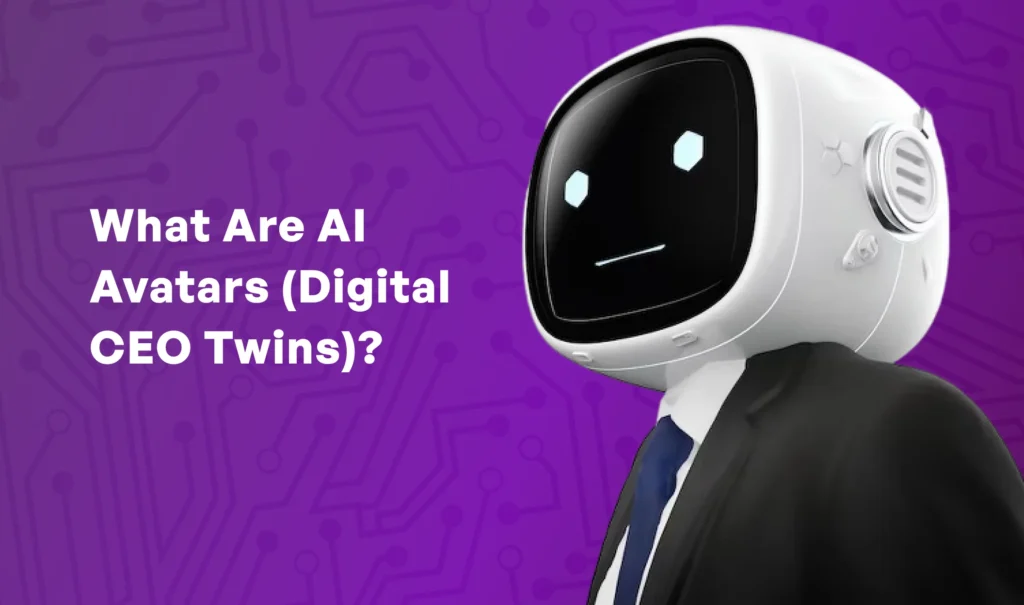Introduction: Are We Ready for an AI CEO?
Imagine logging into a live earnings call, only to realize that the CEO addressing investors isn’t a human—but an impeccably lifelike digital avatar. It looks like the CEO, speaks like them, and answers questions with remarkable fluency and data-backed precision. But it’s running on code, not caffeine.
Welcome to 2025—a year where executive leadership is being reshaped not just by AI tools but by fully interactive, intelligent digital twins. These avatars are no longer the stuff of speculative fiction; they’re active participants in board meetings, training sessions, media briefings, and customer interactions. They’re scalable, multilingual, and tireless.
But what exactly does this mean for the traditional role of a CEO? Are we approaching a future where executive presence is pixelated and streamed instead of flesh-and-blood? Is this the beginning of the end for human CEOs or are these AI avatars simply powerful tools in the modern CEO’s toolkit?
Let’s dive into the future of leadership, where human charisma meets synthetic intelligence.

An AI avatar—also referred to as a “digital twin”—is a hyper-realistic, AI-driven digital representation of a human being. They are advanced digital versions of people that can look, sound, and act like real humans. Thanks to machine learning and natural language processing, they can hold live conversations, give presentations, and even make smart decisions based on data.
These avatars can mimic appearance, tone, facial expressions, and even behavioral nuances. Unlike chatbots or static video messages, digital CEO avatars are interactive and can operate in real-time.
Companies like Synthesia and HeyGen are leading the way with tools that make it easy to create ultra-realistic avatars that can:
- Deliver real-time speeches and announcements
- Interact via text, voice, or video
- Analyze data and generate reports
- Represent the company in public forums
These platforms help executives stay visible and consistent across different channels, making sure their message is always clear and on time.
How AI Avatars (Digital Twins) Work
Behind the scenes, these avatars combine technologies such as:
- Text-to-Speech and Voice Cloning: Tools like ElevenLabs and OpenAI create near-perfect voice replicas.
- Deep Learning and NLP: Language models process inputs, respond contextually, and generate coherent speech.
- Video Synthesis: Platforms like Synthesia, HeyGen, and Hour One generate lifelike avatars from mere photos or video clips.
- Data Integration: These avatars can tap into real-time company dashboards, CRM systems, and knowledge bases.
This allows them to not only “look and sound” like a human executive but also to think and respond like one—at least for defined contexts.
The Corporate Use Cases: How AI Avatars Are Replacing the Zoom Call
1. Earnings Calls & Investor Relations
CEOs of leading tech firms have begun using AI avatars to co-host quarterly earnings calls. A good example is Zoom’s CEO, Eric Yuan who deployed his avatar twin via zoom clips during his company’s earnings call. This is especially powerful for multinational firms where language barriers and scheduling constraints create friction.
This new approach is testing whether AI can handle top executive roles, even acting as the CEO. It shows a growing confidence in AI and a push to simplify leadership tasks with advanced technology.
AI avatars can:
- Simultaneously translate earnings briefings into multiple languages.
- Access real-time financial data.
- Deliver error-free, on-brand messaging across time zones.
In 2024, a startup CEO used a digital twin to deliver a multilingual investor Q&A session, impressing global stakeholders with its fluency and consistency.
2. Internal Communications & Culture Building
AI avatars are transforming how companies communicate internally. CEOs can now use avatars to deliver personalized messages, host virtual town halls, and lead training sessions—without needing to be there in person. This helps ensure the company’s vision and goals are shared consistently across all teams.
With remote and hybrid work environments creating communication gaps. AI avatars step in to deliver:
- On-demand welcome messages for new hires
- Monthly updates directly from the CEO (even if they’re skiing in the Alps)
- Virtual town halls where staff can ask questions via text or video
These avatars ensure that company values, updates, and cultural signals are consistently conveyed—even at scale.
3. Customer Engagement and Brand Representation.
More brands are using AI avatars to interact with customers. These avatars can answer questions, show how products work, and even help with sales. The result is a smooth, engaging, and interactive customer experience. Some brands are using AI avatars as the face of their organization:
- Hosting product launches
- Handling customer support inquiries
- Personalizing sales pitches via interactive videos
Digital avatars can represent the brand in multiple languages, regions, and formats simultaneously—unlocking enormous ROI in global customer experience.
4. Training and Onboarding
AI avatars are revolutionizing corporate training and onboarding of new hires. Picture this:
- An avatar of your CEO walking new recruits through company values.
- Departmental heads (in avatar form) conducting technical onboarding, available 24/7.
- Instant responses to common HR or IT queries—delivered in the brand voice.
This eliminates the need to constantly repeat core training while preserving leadership’s presence throughout the employee journey.
Real-World Adoption: Who’s Using AI Avatars Today?
Companies adopting AI avatars are no longer just startups or early tech adopters. In 2025, we’ve seen real movement across sectors:
- Synthesia reported a 68% increase in enterprise clients leveraging executive avatars for internal video communications.
- HeyGen launched a feature allowing executives to produce localized video updates in 40+ languages with facial realism and emotional nuance.
- Tencent and Alibaba are reportedly experimenting with avatar-driven investor briefings and internal announcements.
Even Elon Musk joked during an X Spaces call that he could “delegate some public speaking to my AI twin.”
Why CEOs Are Embracing Digital Avatars

Let’s break down the value prop from a leadership perspective.
✔️ Scalability and Presence
An AI CEO avatar can be in 10 meetings across 5 time zones before lunch—without breaking a sweat.
✔️ Multilingual Mastery
Speak English, Mandarin, Spanish, and Hindi fluently? Maybe not. But your avatar can.
✔️ Brand Message Consistency
No off-script moments, no tired or stressed delivery. Avatars stay on-message, on-brand, and on-tone—always.
✔️ Real-Time Data Access
Connected to live dashboards, an avatar can relay metrics and projections mid-conversation. No fumbling for stats or outdated PDFs.

With great power comes great responsibility—and AI avatars raise significant concerns.
Authenticity & Trust
As avatars become more lifelike, distinguishing between human and AI interactions becomes challenging. If you can’t tell whether you’re talking to a human or an AI twin, is that misleading? Many advocate for a “disclosure clause” that mandates identifying AI-driven interactions.
Other questions continue to be raised like can investors and employees trust an AI representation? What happens if the avatar malfunctions or gets hacked?
Data Privacy & Security
To sound like a CEO, an avatar needs deep access to their voice, facial data, behavioral cues, and internal documents. This raises alarms around:
- Biometric data misuse.
- Avatar hijacking or deepfake attacks.
- Accidental leaks via data integrations.
Accountability in Public Discourse
If an avatar delivers a controversial statement or makes a financial error, who’s liable? The real CEO? The developers? The company?
Legal frameworks are struggling to catch up. But initiatives are emerging, like ISO’s AI Governance guidelines and the EU AI Act, which may require disclosures and audit trails for AI-led communications.
Employment Displacement
AI avatars are unlikely to replace CEOs entirely, but support roles may be at risk. Think:
- Communications managers
- Speechwriters
- Training facilitators
- HR onboarding reps
As avatars take on more tasks, human roles may need to evolve or specialize further.
“The avatar should complement human leadership, not replace it,” says Dr. Anjali Mehta, an AI ethics expert. “But the temptation to overuse them is real.”
Interactive Quiz: Should Your Company Explore a Digital Avatar?
Take our 60-second self-assessment:
- Do you operate in multiple time zones?
- Is your CEO’s schedule stretched thin?
- Are you undergoing digital transformation?
- Do your audiences include multilingual or tech-savvy customers?
- Would your audience respond well to innovation?
- Would consistency in public messaging give you a competitive edge?
If you checked 3 or more, your organization may benefit from testing a digital CEO twin.
The Path Forward: What Will Digital Avatars Look Like by 2030?
We’re in the early innings of avatar adoption. But trends point toward exponential evolution.
Predicted Milestones (2025–2030)
- 2025–2026: AI avatars co-hosting investor calls, alongside human CEOs.
- 2026–2027: Real-time emotional feedback loops for avatars based on audience facial expressions.
- 2028: Department-specific avatars representing leadership in daily check-ins.
- 2029: Regulation around AI avatar transparency in media and finance.
- 2030: Fully autonomous avatar-led startups or DAOs (Decentralized Autonomous Organizations) with AI CEOs.
By the end of the decade, it’s possible your favorite brand’s public face may never have set foot in an office.
Human Plus Machine: The Hybrid CEO Model
Despite the rise of avatars, the heart of leadership—intuition, ethics, empathy, and vision—remains uniquely human.
Rather than replacement, we’re seeing augmentation.Think of AI avatars as Iron Man suits for executives. They offer:
- Supercharged communication capabilities
- Infinite scalability
- Instant, data-driven insights
But they still need a human pilot. CEOs in 2025 are expected to:
- Curate what their avatars say and do
- Step in for high-touch, nuanced moments
- Use AI tools responsibly to amplify—not dilute—their leadership
Conclusion: The Executive Future is Hybrid
AI avatars aren’t just flashy tech—they’re reshaping what it means to lead, communicate, and connect. They allow executives to do more with less, reach more people, and make faster decisions.
But at the end of the day, an avatar is a reflection. It mirrors the intelligence we feed it, the ethics we encode, and the leadership we project.
So the real question isn’t whether AI avatars will change the CEO role. They already have.
The question is: How will you adapt?
What Do You Think?
Would you trust a company led (in part) by a digital avatar?
Yes – Innovation breeds trust
No – Only humans should lead
Maybe – If there’s human oversight
Drop your comments below.